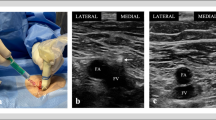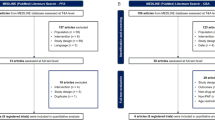Abstract
Purpose
Radiofrequency ablation along the posterior wall of the left atrium may lead to atrioesophageal fistula due to esophageal thermal injury. The purpose of our study was to prospectively investigate whether ablation guided by soluble contrast esophageal visualization (SCEV) reduces injury during atrial fibrillation (AF) ablation.
Methods
Seventy-eight patients with paroxysmal AF undergoing circumferential pulmonary vein isolation (PVI) were randomized to a SCEV group (n = 39) and control group without visualization (n = 39). Cine imaging of the esophagus was performed during soluble contrast swallowing at the beginning of ablation, after adjacent ipsilateral PVI and at the end of the procedure. The ablation lesion set was modified to avoid radiofrequency delivery within the contrast esophagram boundaries. In the control group, a single final ingestion was performed at the end of the procedure. Esophageal injury was assessed by esophagogastroscopy within 24 h in all patients.
Results
In the control group, the ablation lesion crossed over the esophagus in 46.2% of patients, whereas in SCEV group, the ablation line violated the boundaries of the esophagus unavoidably in 15.4% of patients (confidence interval (CI); 1.61–13.98, p = 0.003). The incidence of esophageal injury was significantly lower in patients that underwent ablation with SCEV (5.1% vs. 20.5%, CI; 0.04–1.06, p = 0.042). Regardless of randomization group, patients who received ablation which overlapped the esophagus had a higher incidence of esophageal injury compared with those without overlap (37.5 vs. 1.9%, CI; 3.73–271.37, p = 0.000).
Conclusions
Esophageal contrast visualization helps to reduce the potential for esophageal injury during paroxysmal AF ablation. This simple procedural adjunct has important implications to improve safety of paroxysmal AF ablation procedures globally.




Similar content being viewed by others
References
Cummings JE, Schweikert RA, Saliba WI, Burkhardt JD, Brachmann J, Gunther J, et al. Assessment of temperature, proximity, and course of the esophagus during radiofrequency ablation within the left atrium. Circulation. 2005;112(4):459–64. https://doi.org/10.1161/CIRCULATIONAHA.104.509612.
Schmidt M, Nolker G, Marschang H, Gutleben KJ, Schibgilla V, Rittger H, et al. Incidence of oesophageal wall injury post-pulmonary vein antrum isolation for treatment of patients with atrial fibrillation. Europace. 2008;10(2):205–9. https://doi.org/10.1093/europace/eun001.
Martinek M, Bencsik G, Aichinger J, Hassanein S, Schoefl R, Kuchinka P, et al. Esophageal damage during radiofrequency ablation of atrial fibrillation: impact of energy settings, lesion sets, and esophageal visualization. J Cardiovasc Electrophysiol. 2009;20(7):726–33. https://doi.org/10.1111/j.1540-8167.2008.01426.x.
Martinek M, Nesser HJ, Aichinger J, Boehm G, Purerfellner H. Impact of integration of multislice computed tomography imaging into three-dimensional electroanatomic mapping on clinical outcomes, safety, and efficacy using radiofrequency ablation for atrial fibrillation. Pacing Clin Electrophysiol. 2007;30(10):1215–23. https://doi.org/10.1111/j.1540-8159.2007.00843.x.
Cummings JE, Barrett CD, Litwak KN, Litwak KN, Chowdhury P, Oh S, et al. Esophageal luminal temperature measurement underestimates esophageal tissue temperature during radiofrequency ablation within the canine left atrium: comparison between 8 mm tip and open irrigation catheters. J Cardiovasc Electrophysiol. 2008;19(6):641–4. https://doi.org/10.1111/j.1540-8167.2008.01130.x.
Kanj MH, Wazni OM, Natale A. How to do circular mapping catheter-guided pulmonary vein antrum isolation: the Cleveland Clinic approach. Heart Rhythm. 2006;3(7):866–9. https://doi.org/10.1016/j.hrthm.2006.02.1033.
Singh SM, d'Avila A, Doshi SK, Brugge WR, Bedford RA, Mela T, et al. Esophageal injury and temperature monitoring during atrial fibrillation ablation. Circ Arrhythm Electrophysiol. 2008;1(3):162–8. https://doi.org/10.1161/CIRCEP.107.789552.
Jiang RH, Jiang CY, Sheng X, Zhang ZW, Sun YX, Liu Q, et al. Marked suppression of pulmonary vein firing after circumferential pulmonary vein isolation in patients with paroxysmal atrial fibrillation: is pulmonary vein firing an epiphenomenon? J Cardiovasc Electrophysiol. 2014;25(2):111–8. https://doi.org/10.1111/jce.12288.
Jiang RH, Po SS, Tung R, Liu Q, Sheng X, Zhang ZW, et al. Incidence of pulmonary vein conduction recovery in patients without clinical recurrence after ablation of paroxysmal atrial fibrillation: mechanistic implications. Heart Rhythm. 2014;11(6):969–76. https://doi.org/10.1016/j.hrthm.2014.03.015.
Moreto M. Diagnosis of esophagogastric tumors. Endoscopy. 2005;37(1):26–32. https://doi.org/10.1055/s-2004-826095.
Cummings JE, Schweikert RA, Saliba WI, Burkhardt JD, Kilikaslan F, Saad E, et al. Brief communication: atrial-esophageal fistulas after radiofrequency ablation. Ann Intern Med. 2006;144(8):572–4.
Doll N, Borger MA, Fabricius A, Stephan S, Gummert J, Mohr FW, et al. Esophageal perforation during left atrial radiofrequency ablation: is the risk too high? J Thorac Cardiovasc Surg. 2003;125(4):836–42. https://doi.org/10.1067/mtc.2003.165.
Pappone C, Oral H, Santinelli V, Vicedomini G, Lang CC, Manguso F, et al. Atrio-esophageal fistula as a complication of percutaneous transcatheter ablation of atrial fibrillation. Circulation. 2004;109(22):2724–6. https://doi.org/10.1161/01.CIR.0000131866.44650.46.
Scanavacca MI, D'Avila A, Parga J, Sosa E. Left atrial-esophageal fistula following radiofrequency catheter ablation of atrial fibrillation. J Cardiovasc Electrophysiol. 2004;15(8):960–2. https://doi.org/10.1046/j.1540-8167.2004.04083.x.
Dixit S, Marchlinski FE. How to recognize, manage, and prevent complications during atrial fibrillation ablation. Heart Rhythm. 2007;4(1):108–15. https://doi.org/10.1016/j.hrthm.2006.10.034.
Sanchez-Quintana D, Cabrera JA, Climent V, Farre J, Mendonca MC, Ho SY. Anatomic relations between the esophagus and left atrium and relevance for ablation of atrial fibrillation. Circulation. 2005;112(10):1400–5. https://doi.org/10.1161/CIRCULATIONAHA.105.551291.
Marrouche NF, Guenther J, Segerson NM, Daccarett M, Rittger H, Marschang H, et al. Randomized comparison between open irrigation technology and intracardiac-echo-guided energy delivery for pulmonary vein antrum isolation: procedural parameters, outcomes, and the effect on esophageal injury. J Cardiovasc Electrophysiol. 2007;18(6):583–8. https://doi.org/10.1111/j.1540-8167.2007.00879.x.
Halbfass P, Pavlov B, Muller P, Nentwich K, Sonne K, Barth S, et al. Progression from esophageal thermal asymptomatic lesion to perforation complicating atrial fibrillation ablation: a single-center registry. Circ Arrhythm Electrophysiol. 2017;10(8). https://doi.org/10.1161/CIRCEP.117.005233.
Aupperle H, Doll N, Walther T, Kornherr P, Ullmann C, Schoon HA, et al. Ablation of atrial fibrillation and esophageal injury: effects of energy source and ablation technique. J Thorac Cardiovasc Surg. 2005;130(6):1549–54. https://doi.org/10.1016/j.jtcvs.2005.06.052.
Redfearn DP, Trim GM, Skanes AC, Petrellis B, Krahn AD, Yee R, et al. Esophageal temperature monitoring during radiofrequency ablation of atrial fibrillation. J Cardiovasc Electrophysiol. 2005;16(6):589–93. https://doi.org/10.1111/j.1540-8167.2005.40825.x.
Muller P, Dietrich JW, Halbfass P, Abouarab A, Fochler F, Szollosi A, et al. Higher incidence of esophageal lesions after ablation of atrial fibrillation related to the use of esophageal temperature probes. Heart Rhythm. 2015;12(7):1464–9. https://doi.org/10.1016/j.hrthm.2015.04.005.
McCall R, Thomas SP. Esophageal hematoma complicating catheter ablation for atrial fibrillation. J Cardiovasc Electrophysiol. 2009;20(2):221–3. https://doi.org/10.1111/j.1540-8167.2008.01272.x.
Kumar S, Ling LH, Halloran K, Morton JB, Spence SJ, Joseph S, et al. Esophageal hematoma after atrial fibrillation ablation: incidence, clinical features, and sequelae of esophageal injury of a different sort. Circ Arrhythm Electrophysiol. 2012;5(4):701–5. https://doi.org/10.1161/CIRCEP.112.970624.
Acknowledgments
We thank Professor Roderick Tung, MD, FHRS, and Professor Michael M. Shehata MD, FHRS from USA and Clement Lau, MBChB from UK for their help in the English writing, editing, and thoughtful review of the manuscript.
Author information
Authors and Affiliations
Corresponding author
Additional information
Publisher’s note
Springer Nature remains neutral with regard to jurisdictional claims in published maps and institutional affiliations.
Rights and permissions
About this article
Cite this article
Ye, Y., Chen, Sq., Lu, Yf. et al. PV isolation guided by esophageal visualization with a tailored ablation strategy for the avoidance of esophageal thermal injury: a randomized trial. J Interv Card Electrophysiol 58, 219–227 (2020). https://doi.org/10.1007/s10840-019-00572-5
Received:
Accepted:
Published:
Issue Date:
DOI: https://doi.org/10.1007/s10840-019-00572-5




